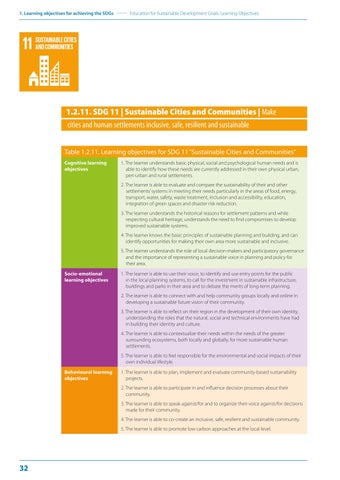1. Learning objectives for achieving the SDGs
Education for Sustainable Development Goals: Learning Objectives
1.2.11. SDG 11 | Sustainable Cities and Communities | Make cities and human settlements inclusive, safe, resilient and sustainable Table 1.2.11. Learning objectives for SDG 11 “Sustainable Cities and Communities” Cognitive learning objectives
1. The learner understands basic physical, social and psychological human needs and is able to identify how these needs are currently addressed in their own physical urban, peri-urban and rural settlements. 2. The learner is able to evaluate and compare the sustainability of their and other settlements’ systems in meeting their needs particularly in the areas of food, energy, transport, water, safety, waste treatment, inclusion and accessibility, education, integration of green spaces and disaster risk reduction. 3. The learner understands the historical reasons for settlement patterns and while respecting cultural heritage, understands the need to find compromises to develop improved sustainable systems. 4. The learner knows the basic principles of sustainable planning and building, and can identify opportunities for making their own area more sustainable and inclusive. 5. The learner understands the role of local decision-makers and participatory governance and the importance of representing a sustainable voice in planning and policy for their area.
Socio-emotional learning objectives
1. The learner is able to use their voice, to identify and use entry points for the public in the local planning systems, to call for the investment in sustainable infrastructure, buildings and parks in their area and to debate the merits of long-term planning. 2. The learner is able to connect with and help community groups locally and online in developing a sustainable future vision of their community. 3. The learner is able to reflect on their region in the development of their own identity, understanding the roles that the natural, social and technical environments have had in building their identity and culture. 4. The learner is able to contextualize their needs within the needs of the greater surrounding ecosystems, both locally and globally, for more sustainable human settlements. 5. The learner is able to feel responsible for the environmental and social impacts of their own individual lifestyle.
Behavioural learning objectives
1. The learner is able to plan, implement and evaluate community-based sustainability projects. 2. The learner is able to participate in and influence decision processes about their community. 3. The learner is able to speak against/for and to organize their voice against/for decisions made for their community. 4. The learner is able to co-create an inclusive, safe, resilient and sustainable community. 5. The learner is able to promote low carbon approaches at the local level.
32


